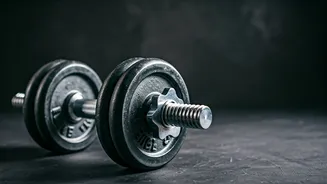Tip 1: Progressive Overload
The first essential tip revolves around 'progressive overload.' This principle underscores the need to gradually increase the demands placed on your muscles
over time. Instead of sticking to the same weight or resistance level, the goal is to consistently challenge your body. This can be achieved in several ways, such as by lifting heavier weights, increasing the number of repetitions you perform, or reducing rest times between sets. For example, if you typically bench press 50 kg for 10 repetitions, consider gradually increasing the weight to 52.5 kg or 55 kg over time. Alternatively, you could aim to perform 12 repetitions with the same weight. By consistently pushing your body beyond its current capacity, you stimulate muscle growth and metabolism, leading to more effective weight loss and overall fitness gains. Regularly track your progress, which will help you in monitoring how you're implementing the progressive overload principle. This way, you can clearly see the improvements you're making and ensure that your workouts continue to be challenging and beneficial. Furthermore, remember to listen to your body and adjust your progression based on your individual capabilities and recovery needs to prevent injuries.
Tip 2: Track Your Lifts
The second critical tip focuses on the importance of 'tracking your lifts.' Keeping a detailed record of your workouts allows you to monitor your progress effectively and ensure that you're implementing progressive overload consistently. This can be done using a simple notebook, a fitness app, or a spreadsheet. Write down the exercises you perform, the weight you lift, the number of repetitions, and the number of sets. This allows you to identify patterns and trends in your performance. For instance, if you consistently increase the weight you lift over time, it's a clear indication that you're making progress. Furthermore, tracking your lifts helps you to stay motivated and accountable. Seeing your progress visually can be a powerful motivator to keep pushing yourself. It also enables you to make informed decisions about your workouts. If you find that you're not seeing the desired results, you can analyze your workout logs to identify areas where you may need to adjust your routine, such as increasing the weight, altering the number of repetitions, or changing the exercise. Remember to include all the key parameters of your workout, like warm-up details, cool-down, and any variations in your workout routine that might impact your performance. Over time, your data gives you insights and lets you optimize your exercise and get better results.














